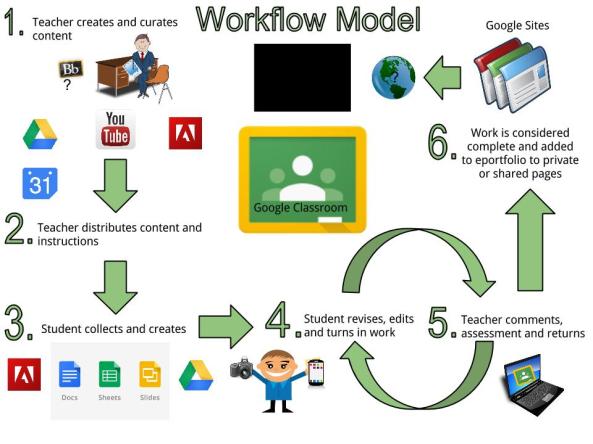There is no question that kids (and adults) love shiny new toys and for educators, digital badging is trending as a practice to aid motivation, learning and student achievement. Anyone familiar with boys or girls scouts (my son is a cub!) know that badging is not really new and like the military serves as a critical element in their programme. Badging is used as motivation for encouraging their members to learn, achieve and is proudly displayed on sashes and uniforms during ceremonies or special occasions.
Today in education, students today of all ages can have access to a (free!) digital space (call it digital portfolios, blogs, websites or even cloud storage) where earned badges and achievements now have a place to be displayed to a potentially global audience. Dependent on the age of the student, their digital space can be teacher or student-curated. The opportunity to modify the degree of sharing from private or public and access to specific groups like parents or experts in between. However, I cannot help but ask whether digital badges aids motivation to learn or even diminishes it? I was inspired to this critical analysis from my own experiences, discussions in a class on Behaviorism and Jackie Gerstein’s well articulated blog post called “Why I hate digital badges.” (Spoiler alert: She doesn’t but is rightfully critical and cautious that badging should not replace evidence of learning among other ideas.)
However, I find that badges can aid the assessment process when used to celebrate, recognize and motivate student achievement and learning. Offering badges can offer students choice to earn, achieve and learn but should be not linear in their application (i.e. one badge at a time.) This experience will be familiar to those students who commonly unlock achievements in video games. (And I have a sneaking suspicion we all know might know a few student gamers in our classes:) Allowing students the option to complete tasks and curate projects in any order I believe replicates a differentiated instruction strategy of choice boards and would be appealing for students. And like games, some badges would be easy to earn than other more complex requirements.
I also like how badges can be a tangible reward that might be placed on blog, wiki or social media site. And after reading Jackie Gerstein’s article, I agree that the matching of badges with a digital portfolios or web spaces is essential so that interested parties can “click through” hyperlinks to examine related photos, videos, files and creative work for specific evidence of learning at a level of detail dependent on the observer. However, I am admittedly reluctant of the place of badges when transferred from one class to another. In other words, even the most well designed and transparent badging system is best used over the course of one school year with one teacher. Although Mozilla hope to apply standards to badging through their open source Open Badges initiative. (So watch this space!) Even higher educational institutions are getting in on the badging act.
Badges allow students to be rewarded for selected and specific achievements within a unit or course of study. In a mark-based system of assessment with rubrics, students may be reluctant to work towards something that is not marked. No question and full disclosure here, some students do struggle with the idea of shifting from a mark-based model to a standards-based one. Badging can help with the assessment process as students are able to be recognized personally for their achievements when achieving a badge by the instructor and can be key collaborators for peers interested in earning a particular badge. On that last point, badging is also a differentiation tool as like all initiatives Roger’s bell curve applies. Having badging will motivate some students (and I would argue a large majority) but may not be for all and I think that is ok. An educator might have to use different strategies to motivate, inspire, support and teach. (Yes, badging is certainly “no magic bullet” but can an evolving practice that I argue offers benefits to all involved in the learning process.)
I have been experimenting with badges in both Primary, Junior and Senior environments and find them a useful to aid the assessment process.
Below is a diagram of workflow in my classes and badging would enter in between Stage 5 and 6 of the process where projects are commented on, assessed and returned. As for platforms, I have been using KidBlog (sample) with primary students and Google Sites with both junior (sample) and senior (sample) students. Although, next steps with Grade 12 students would be to use services like Squarespace and the Adobe Creative Cloud as requested (Their requests and they are right…)

How to create badges
Creating using Power Point
Creating using Credly.com
Also classbadges.com is an excellent resource for creating badges and even collecting embeddable options. For me, I have a folder that I use with all my badges in it (HERE) and create and collaborative with colleagues on Google documents with the requirements for each badges.
Further discussion on badging
I look forward to sharing my continuing practice with badging and eportfolios but remember that as assessment change, adapt and evolve (hopefully for the better) celebrating and encouraging student achievement is fundamental.
Here are a small sample of sites on badging. I look forward to further discussions and chats on Twitter and specifically at #badgechatk12.
Using badging with K-12 – http://www.facultyfocus.com/articles/teaching-with-technology-articles/using-badges-classroom-motivate-learning/
Higher Education example – Masters in Education through Badging – http://etale.org/main/2014/09/07/you-can-now-earn-a-masters-degree-in-edtech-through-competency-based-digital-badges/
Shelly Terrell’s slidedeck on adapting assessment to be missions – http://www.slideshare.net/ShellTerrell/meaningful-elearning-with-digital-badges-missions
Jackie Gerstein’s blog post with a critical examination of digital badging – https://usergeneratededucation.wordpress.com/2013/03/16/i-dont-get-digital-badges/
Kate Ash’s features of digital badging – http://www.edweek.org/dd/articles/2012/06/13/03badges.h05.html?
Nellie Deutsch’s post on badges as virtual rewards – http://www.emergingedtech.com/2013/06/the-evolving-use-of-badges-in-education/

